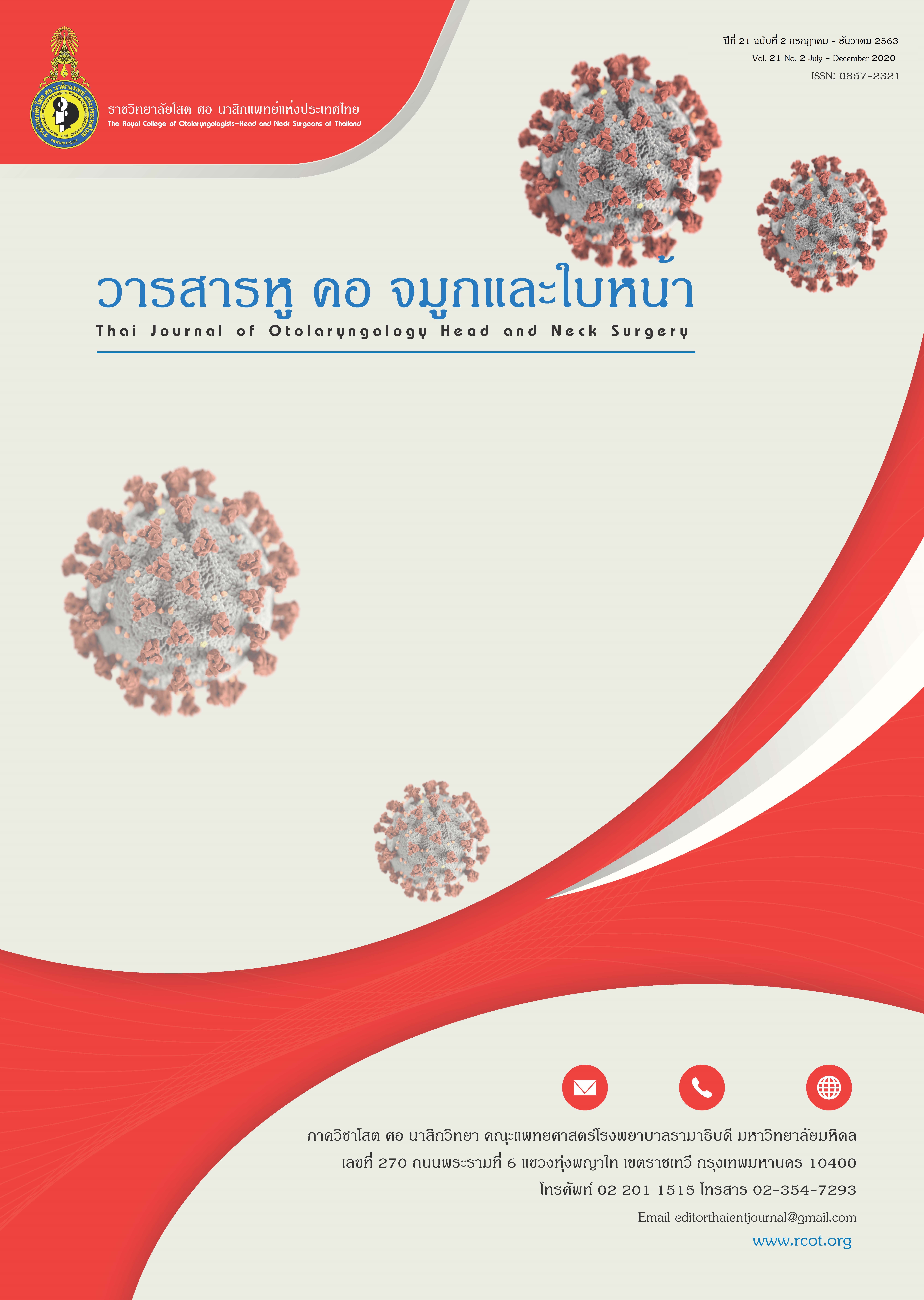The cost effectiveness newborn hearing screening at Takuapa hospital
Main Article Content
Abstract
Abstract
Background: Hearing impairment in children across the world constitutes a particularly serious obstacle to their optimal development and education, including language acquisition.
Objectives: This study aims to determine cost effectiveness of the universal newborn hearing screening compare with high risk newborn hearing screening program in Takuapa Hospital.
Method: The economic analysis used a decision tree approach to determine the cost-effectiveness of newborn hearing screening strategies revealed that a universal newborn hearing screening in 5 years (January, 2016-2020).
Result: The high risk hearing screening cost was 107,481.49 baht per year 422.25 baht per person (Unit cost), while the cost of universal hearing screening was 701,842.24 baht per year 173.38 baht per person (Unit cost). Universal newborn hearing screening could detect 3 hearing loss and high risk screening were 1 case, low risk screening 2 cases respectively. The incremental cost per case detected for the universal hearing screening vs. high risk hearing screening protocol is estimated to be 233,947.41 baht. 2 newborns hearing loss refer for cochlear implant. Sensitivity analysis of variables for universal hearing screening, the baseline prevalence of hearing impairment affected the results.
Conclusion: This study found that the universal hearing screening method had the highest cost and highly effective to determine newborn hearing loss.
Article Details
ต้นฉบับที่ส่งมาพิจารณายังวารสารหู คอ จมูก และใบหน้า จะต้องไม่อยู่ในการพิจารณาของวารสารอื่น ในขณะเดียวกันต้นฉบับที่จะส่งมาจะผ่านการอ่านโดยผู้ทรงคุณวุฒิ หากมีการวิจารณ์หรือแก้ไขจะส่งกลับไปให้ผู้เขียนตรวจสอบแก้ไขอีกครั้ง ต้นฉบับที่ผ่านการพิจารณาให้ลงตีพิมพ์ถือเป็นสมบัติของวารสารหู คอ จมูกและใบหน้า ไม่อาจนำไปลงตีพิมพ์ที่อื่นโดยไม่ได้รับอนุญาต
ตารางแผนภูมิ รูปภาพ หรือข้อความเกิน 100 คำที่คัดลอกมาจากบทความของผู้อื่น จะต้องมีใบยินยอมจากผู้เขียนหรือผู้ทรงลิขสิทธิ์นั้นๆ และใหร้ะบุกำกับไว้ในเนื้อเรื่องด้วย
References
1. Roberts JE, Wallace IF, Brackett D. Development of speech and language. In: Lalwani AK, Grundfast KM, eds. Pediatric Otology and Neurotology. Philadelphia: Lippincott-Raven Publishers; 1998: 39-47.
2. Northern JL, Epstein S. Neonatal hearing Screening. In: Lalwani AK, Grundfast KM, eds. Pediatric Otology and Neurotology. Philadelphia: Lippincott-Raven Publishers;1998: 155-62
3. Fortnum HM, Summerfield AQ, Marshall DH, Davis AC, Bamford JM. Prevalence of permanent childhood hearing impairment in the United Kingdom and implications for universal neonatal hearing screening: questionnaire based ascertainment study. BMJ 2001; 323: 536-40.
4. Wartkin PM, Baldwin M. Confirmation of deafness in infancy. Arch Dis Child 1999; 81: 380-9.
5. Wessex Universal Neonatal Hearing Screening Trial Group. Controlled trial of universal neonatal screening or early identification of permanent children hearing impairment. Lancet 1998; 352: 1957-64.
6. Thompson DC, McPhillips H, Davis RL, Lieu TL, Homer CJ, Helfand M. Universal newborn hearing screening: summary of the evidence. JAMA 2001: 286: 2000-10.
7. Sininger YS. Screening for hearing loss in neonates: Where do we stand? Adv Otolaryngol Head and Neck Surg 1998; 12: 181-203.
8. จันทร์ชัย เจรียงประเสริฐ, กฤษณา เลิศสุขประเสริฐ, ลลิดา เกษมสุวรรณ, ประชา นันท์นฤมิต. การตรวจคัดกรองการได้ยินในทารกแรกเกิดด้วยเครื่อง ตรวจวัดเสียงสะท้อนของหูชั้นใน. วารสารหู คอ จมูกและใบหน้า 2546; 4:27-41.
9. Yoshinaga-Itano C, Apuzzo ML. Identification of hearing loss after age 18 months is not early enough. Am Ann Deaf 1998; 143: 380-7.
10. Year 2019 Position Statement: Principles and Guidelines for Early
Hearing Detection and Intervention Programs. The Journal of Early Hearing Detection and Intervention 2019; 4(2): 1-44.
11. Early identification of hearing impairment in infants and young children. NIH Consens Statement 1993; 11: 1-24.
12. Newborn and infant hearing screening. Current issues and guiding principles for action. WHO Library Cataloguing-in-Publication Data outcome of WHO informal consultation held at WHO headquarters, Geneva, Switzerland, 09-10 November 2009.
13. American Speech-Language-Hearing Association. (2013). Expert Panel Recommendations on Newborn Hearing Screening. Retrieved from www.asha.org
14. Joint Committee on Infant Hearing: American Academy of Audiology; American Academy of Pediatrics; American Speech-Language-Hearing Association; Directors of Speech and Hearing Programs in State Health and Welfare Agencies. Year 2007 position statement: principles and guidelines for early hearing detection and intervention programs. Pediatrics 2008;120(4):898-921.
15. การสำรวจความพิการ พ.ศ. 2550 กลุ่มสถิติสังคม สำนักสถิติเศรษฐกิจสังคม และประชามติ สำนักงานสถิติแห่งชาติ
16. Burke MJ, Shenton RC, Taylor MJ. The economics of screening infants at risk of hearing impairment: an international analysis. Int J Pediatr Otorhinolaryngol 2012; 76:212-8.
17. Kemper AR, Downs SM. A cost - effectiveness analysis of newborn hearing screening strategies. Arch Pediatr Adolesc Med 2000; 154: 484-8.
18. Kezirian EJ, White KR, Yueh B, Sullivan SD. Cost and cost- effectiveness of universal screening for hearing loss in newborns. Otolaryngol Head Neck Surg 2001; 124:359-67.
19. การประเมินเทคโนโลยีการผ่าตัดฝังประสาทหูเทียม: มุมมองด้านเศรฐศาสตร์และสังคม. โครงการประเมินเทคโนโลยีและนโยบายด้านสุขภาพ (Health Intervention and Technology Assessment Program)


